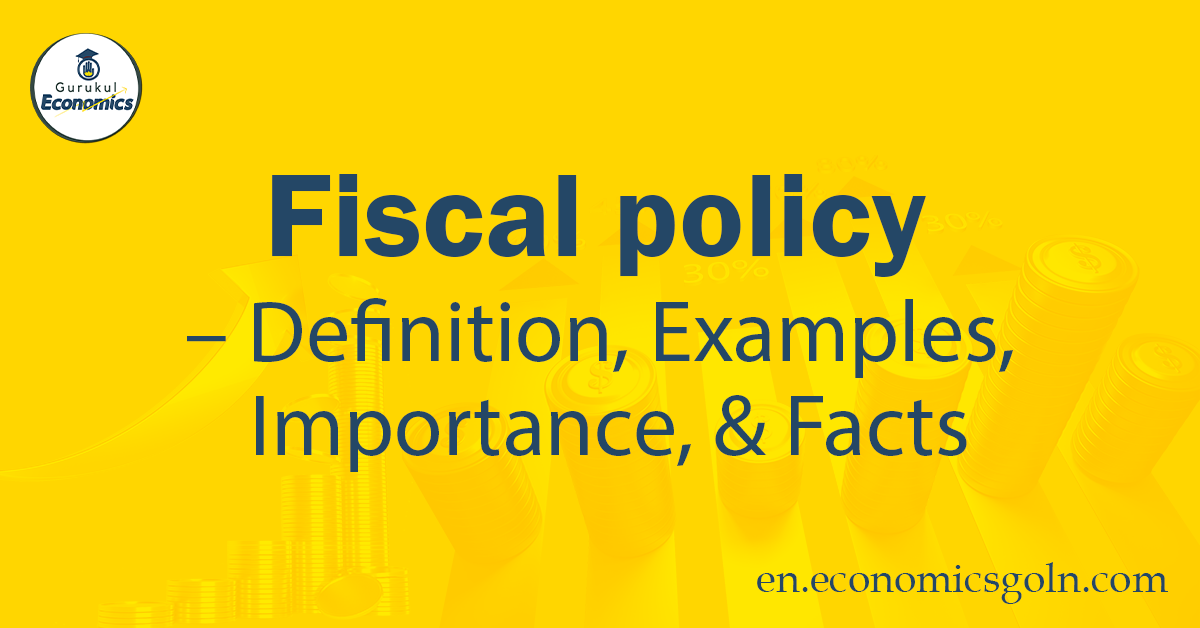Fiscal policy plays a crucial role in the functioning of modern economies. It refers to the government’s use of taxation and public spending to influence the economy’s overall performance. By manipulating fiscal policy, governments can stabilize economic fluctuations, promote growth, and address various socio-economic challenges. This article provides a detailed overview of fiscal policy, including its definition, examples, importance, and key facts.

Definition of Fiscal Policy:
Fiscal policy encompasses the decisions and actions taken by the government regarding taxation, public spending, and borrowing. It aims to achieve specific economic objectives such as maintaining price stability, promoting employment, and fostering sustainable economic growth. Fiscal policy operates alongside monetary policy, which focuses on controlling the money supply and interest rates. Together, these two policy tools form the foundation of macroeconomic management.

Examples of Fiscal Policy Measures:
- Taxation: Governments can use taxation to influence economic activity. For instance, during periods of high inflation, they may increase taxes to reduce consumer spending and curb inflationary pressures. Conversely, during economic downturns, governments may reduce taxes to stimulate consumer spending and boost economic growth.
- Government Spending: Governments can directly impact the economy through their spending decisions. During recessions or periods of low economic activity, governments may increase public expenditure on infrastructure projects, education, or healthcare to create jobs and stimulate economic activity. Increased spending can lead to higher aggregate demand and encourage business investment.
- Budget Deficit or Surplus: Governments can intentionally create budget deficits or surpluses as part of their fiscal policy. A budget deficit occurs when government spending exceeds tax revenues, leading to increased borrowing. This can inject additional money into the economy and stimulate growth. On the other hand, a budget surplus arises when tax revenues exceed government spending, allowing for the reduction of public debt and potential savings for future use.
- Automatic Stabilizers: Certain fiscal policy measures are designed to automatically adjust during economic fluctuations. Unemployment benefits and progressive income tax systems are examples of automatic stabilizers. During an economic downturn, unemployment benefits increase, providing income support to those affected and boosting overall demand. Similarly, progressive income tax systems ensure that individuals with higher incomes pay a larger proportion of their earnings as taxes, helping to redistribute wealth.

Importance of Fiscal Policy:
- Economic Stabilization: Fiscal policy can help stabilize the economy during periods of recession or inflation. By adjusting tax rates and government spending, policymakers can influence aggregate demand, manage inflationary pressures, and support economic growth.
- Addressing Socio-Economic Challenges: Fiscal policy can address various socio-economic challenges such as income inequality, poverty, and unemployment. Governments can implement redistributive tax policies to reduce wealth disparities, increase social welfare spending to alleviate poverty, and invest in job creation programs to combat unemployment.
- Investment in Public Goods: Fiscal policy enables governments to allocate resources towards public goods and services that benefit society as a whole. This includes investments in infrastructure, education, healthcare, research and development, and other areas that foster long-term economic growth and improve citizens’ well-being.
- Counteracting Business Cycles: Fiscal policy can counteract the ups and downs of the business cycle. During periods of economic expansion, fiscal restraint can prevent excessive inflation and asset bubbles. Conversely, during recessions, expansionary fiscal policy can provide a boost to demand and revive economic activity.

Key Facts about Fiscal Policy:
- Fiscal policy can be expansionary or contractionary. Expansionary fiscal policy involves increasing government spending or reducing taxes to stimulate economic activity, while contractionary fiscal policy involves decreasing spending or increasing taxes to rein in inflation or reduce budget deficits.
- Fiscal policy is typically implemented through the annual budgetary process, where governments outline their revenue and expenditure plans for the upcoming fiscal year.
- Fiscal policy decisions have both short-term and long-term impacts on the economy. The effectiveness of fiscal policy depends on various factors, such as the size of the fiscal multiplier, the responsiveness of individuals and businesses to policy changes, and the overall health of the economy.
- Fiscal policy must strike a balance between promoting economic growth and maintaining fiscal sustainability. Excessive reliance on deficit spending can lead to rising public debt levels, potentially crowding out private investment and jeopardizing long-term economic stability.

Fiscal policy encompasses the use of government taxation, spending, and borrowing to influence the economy. It plays a crucial role in stabilizing economies, addressing socio-economic challenges, and promoting long-term growth. By employing fiscal policy effectively, governments can steer their economies towards prosperity while ensuring fiscal sustainability and social welfare.
See more:
